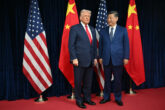March 29, 2024
Countering Coercion
Managing Chinese Gray Zone Activity in the South China Sea and Indian Ocean Region
Executive Summary
The People’s Republic of China (PRC or China) has been engaging in gray zone activity—coercive behavior that is aimed at changing the status quo but that is below a threshold that would prompt a military response—particularly against the Philippines in the South China Sea (SCS), and these actions are raising tensions in the Indo-Pacific.1 Washington must closely monitor the situation and take steps to help protect the sovereignty of Southeast Asian nations from PRC intimidation and territorial encroachment.
China makes ambiguous claims to 90 percent of the 1.3 million square miles of the South China Sea, including waters within the exclusive economic zones of Brunei, Indonesia, Malaysia, the Philippines, and Vietnam. Projecting power and dominating the South China Sea, with its critical resources and central role in global trade—around $3 trillion worth of commerce transits the seaways annually—is a top national security and foreign policy goal for China.2
PRC maritime bullying is not new, but it has intensified in the past few years, especially against the Philippines. Beijing aims to convince Manila to give up its claim to Second Thomas Shoal, an underwater reef located in the Spratly Islands of the South China Sea. The Philippines makes its claim to the shoal by housing a small contingent of marines aboard a World War II–era ship, the BRP Sierra Madre, that was intentionally grounded there in 1999.3
Philippines-China tensions in the South China Sea threaten to involve the United States, which has been a treaty ally of the Philippines for over 70 years. Despite the risk that tensions could further escalate, Washington continues to stand firmly behind Manila as it employs asymmetric tactics to push back against Chinese behavior.4
PRC maritime activities and goals in the Indian Ocean Region (IOR), for the time being, are focused on protecting China’s economic interests (80 percent of its energy imports flow through the Indian Ocean), gathering intelligence, and projecting power, not on asserting maritime claims.5 However, China’s unrelenting aggression in the SCS has raised concern that Beijing will soon begin to demonstrate similar behavior in the IOR. Over the past 15 to 20 years, China has expanded from sporadic to regular presence in the Indian Ocean through its naval ships, research vessels, and fishing fleets, as well as a military base. The United States and its allies and partners must not be complacent about PRC actions in the Indian Ocean Region, especially China’s submarine port visits and docking of dual-use ships such as in Sri Lanka and, more recently, Maldives.
Due to the high stakes involved, the United States and its allies and partners must balance the need to deter China with the need to avoid military escalation when responding to PRC gray zone acts. When there are violations of international law and norms or when the lives of official personnel or civilians are threatened, Washington and its allies must respond. Moving forward, the United States should:
Deepen commitment to its relationship with the Philippines and enhance partnerships with other Southeast Asian nations, both diplomatically and militarily.
The United States should focus on building capacity not only of the Philippines but also of Vietnam, Indonesia, Malaysia, and other Southeast Asian nations. The United States should also facilitate efforts to increase transparency about what is happening in the maritime commons and build international support for pushing back against China’s maritime bullying.
Be prepared to take additional steps to protect Philippine vessels, including those involved in fortifying the Philippines’ presence at Second Thomas Shoal.
Some analysts are calling for the establishment of a combined U.S.-Philippines outpost at Second Thomas Shoal.6 However, there are steps short of this escalatory move that send a similar signal to Beijing and help the Philippines maintain control of the reef. These include providing regular U.S. naval escorts for Philippine vessels, whether they are resupplying troops on the Sierra Madre or involved in efforts to construct more permanent structures on the reef, and increasing intelligence, surveillance, and reconnaissance assets to the area around Second Thomas Shoal.
Encourage Southeast Asian nations to employ creative and peaceful steps to protect their own sovereignty and to highlight Chinese encroachments when they occur.
The Southeast Asian nations must be willing to levy costs on China for its aggression, or it will only escalate. These steps should focus mainly on the information space and avoid employing military capabilities that would be more likely to raise tensions to a dangerous level.
Leverage AUKUS capabilities.
The United States and Australia are time-tested allies and are increasingly partnering on issues stretching from the Pacific to the Indian Oceans.7 In addition to their bilateral partnership, they participate in multilateral groupings such as Five Eyes. The Australia-United Kingdom-United States (AUKUS) partnership increasingly presents opportunities to counter gray zone activity through technological developments, intelligence sharing, and operations. For example, in December 2023, the AUKUS defense ministers discussed plans for deploying shared artificial intelligence algorithms to advance antisubmarine warfare capabilities.8 The establishment of Submarine Rotational Force-West in Australia should include the objective of monitoring gray zone activity from its Indian Ocean vantage point.
Enlist Quad members.
While the Quad (Australia, India, Japan, and the United States) has been reluctant to operate along explicitly military lines, its work to expand maritime domain awareness such as through the Indo-Pacific Partnership for Maritime Domain Awareness initiative helps raise capability in the Indian Ocean and fortifies partner states against gray zone threats.9 The Quad members should also informally discuss South China Sea contingencies to generate ideas and considerations for deterring and, if needed, responding to such a crisis. Additionally, the Quad partners should collaborate to increase investments in sustainable port development in South and Southeast Asia. The recent U.S. International Development Finance Corporation announcement of $553 million in financing for a deep-water shipping container terminal that an Indian company is developing at the Port of Colombo is a notable initiative that can help balance increased Chinese involvement in port development in Sri Lanka. Finally, the Quad should continue to enhance humanitarian assistance and disaster relief activities in the South China Sea and Indian Ocean regions.
Partner with India.
India should take the leading role in countering China’s gray zone threats in the Indian Ocean, but the United States and its allies such as Australia should support and bolster Indian efforts. For example, the Indian Navy and naval strategists are studying different approaches and technologies that can counter China’s gray zone operations.10 Their insights present opportunities for greater collaboration by New Delhi, Washington, and Canberra.
Work with other key partners, such as France.
Beyond the Quad, the United States and Australia should work more closely with other key allies and partners. For example, France is also a key partner in the Indo-Pacific, with territory and nationals to defend.11 While the AUKUS announcement in 2021 resulted in a public controversy between Australia and France, both countries appear to have moved past this episode. As the United States’ oldest ally and an early mover in developing an Indo-Pacific strategy, France is a key partner for both the United States and Australia to embrace in countering gray zone activity.
Maintain tempo of multilateral naval exercises and joint patrols and sails to signal solidarity among U.S. allies and partners.
The frequency of U.S.-led multilateral naval activity in the form of exercises and joint sails has been impressive and should continue apace. The involvement of a variety of like-minded nations means that the burden can be shared and that the United States does not always need to participate. For example, India conducted its first naval exercise with the Association of Southeast Asian Nations (ASEAN) members in the South China Sea in May 2023.
Rely on multilateral mechanisms to push back against China’s maritime aggression.
The 2016 international arbitral ruling has become an indispensable tool for rejecting China’s sweeping maritime claims. There is a need for more such international efforts that call out China’s illegal behavior that undermines countries’ sovereignty. The United States and its allies and partners should support nations that bring new cases with similarly strong evidence to the tribunal against Chinese maritime claims.
Invest in regional architecture and norms.
The United States, Australia, and other key partners should continually invest in maintaining Indian Ocean stability. Dispatching senior officials to participate in regional architecture, such as the Indian Ocean Rim Association, which Sri Lanka is chairing for the next two years, is one meaningful way to do this. Investing more resources in maritime capacity building such as legal training is another way. Both the United States and Australia currently conduct capacity building with smaller Indian Ocean partners.12
Continue to raise the issue of China’s aggressive behavior in the SCS in the newly resumed U.S.-China military-to-military talks.
The U.S. Department of Defense statement on recently held defense talks between Washington and Beijing indicated that the U.S. side highlighted PRC harassment of Philippine vessels operating in the SCS as a particular area of concern.13 U.S. officials should continue to highlight to their Chinese counterparts that Washington will stand by its allies and partners when there are threats to their territorial or maritime sovereignty. It is critical for the United States to send clear and repeated messaging in this regard.
Introduction
China’s gray zone activity—coercive behavior that is aimed at changing the status quo but that is below a threshold that would prompt a military response—particularly against the Philippines in the past year, is becoming an increasing global concern.14 China’s aggressive behavior in the South China Sea (SCS) has already led to confrontation between the United States (a defense ally of the Philippines since 1951) and China, and could even cause a lethal conflict between the two major powers. The Pentagon’s 2023 Annual Report to Congress: Military and Security Developments Involving the People’s Republic of China details “multiple coercive actions” in the South China Sea in what “appear to have been . . . a centralized, concerted campaign . . . to coerce a change in lawful U.S. operational activity, and that of U.S. allies and partners.”15 Part of the problem lies in the fundamentally different views between Washington and Beijing about sovereignty claims, international law, and acceptable maritime operations.
While the United States’ strategic priority is deterring the People’s Republic of China (PRC) from making military advances against Taiwan, Washington must also closely monitor PRC activities in the South China Sea and take steps to help protect the sovereignty of Southeast Asian nations from PRC intimidation and territorial encroachment. Some observers argue that it is not worth risking the South China Sea becoming another flashpoint between Washington and Beijing, and thus Washington should leave the maritime disputes to the claimants themselves. However, turning a blind eye to increasing PRC aggression in the South China Sea would discourage Southeast Asian nations and force them to accept PRC hegemony in the region, which would play into China’s strategy of circumscribing the role of the United States and undermining its influence in the broader Indo-Pacific. While Washington cannot halt all aggressive behavior, the stakes are higher where it has established a U.S. presence, made alliance commitments (i.e., with the Philippines), or declared U.S. intentions to preserve the status quo. Washington must not make the mistake it made over a decade ago when it failed to challenge China’s militarization of its artificial islands in the region.
PRC maritime activities and goals in the Indian Ocean Region (IOR), for the time being, are focused on protecting its economic interests (80 percent of its energy imports flow through the Indian Ocean), gathering intelligence, and projecting power—not on asserting maritime claims.16 However, China’s unrelenting aggression in the SCS has raised concern that Beijing will soon begin to demonstrate similar behavior in the IOR. Over the past 15 to 20 years, China has expanded from sporadic to regular presence in the Indian Ocean through naval ships, research vessels, and fishing fleets, as well as a military base. The United States and its allies and partners must not be complacent about PRC actions in the Indian Ocean Region, especially China’s submarine port visits and docking of dual-use ships such as in Sri Lanka and, more recently, Maldives.
This paper examines China’s maritime goals and activities in the South China Sea and Indian Ocean regions, giving particular attention to brewing tensions between China and the Philippines over a small outpost that the Philippines has controlled for the past 25 years. The paper examines responses within the region to China’s growing maritime presence and its gray zone activity and discusses the future implications for the United States and its closest allies and partners. Finally, the paper puts forth a series of policy recommendations for the United States to improve maritime security in these two vital regions and shape the strategic environment to deter Chinese maritime actions that seek to disrupt the rules- based order in the Indo-Pacific.
- Lisa Curtis, “Holding the Line against China’s Maritime Bullying: The Philippines Sets a New Standard,” The Diplomat, October 26, 2023, https://thediplomat.com/2023/10/holding-the-line-against-chinas-maritime-bullying-the-philippines-sets-a-new-standard. ↩
- Alice Scarsi, “WW3 Fears as Country with Weaker Army Than China Issues Three-Word Warning to Xi Jinping,” Express, December 15, 2023, https://www.express.co.uk/news/world/1845861/south-china-sea-tensions-china-philippines; Dung Huynh, “Facing the Ravenous Sea Dragon: How Weaker Nations Confront Chinese Coercion in the South China Sea” (Santa Monica, CA: RAND Corporation, 2022), 67, https://www.rand.org/pubs/rgs_dissertations/RGSDA2470-1.html. ↩
- Blake Herzinger, “It’s Time to Build Combined Forward Operating Base Sierra Madre,” War on the Rocks, September 11, 2023, https://warontherocks.com/2023/09/its-time-to-build-combined-forward-operating-base-sierra-madre. ↩
- Curtis, “Holding the Line against China’s Maritime Bullying: The Philippines Sets a New Standard.” ↩
- For the purposes of this paper, Indian Ocean Region refers mainly to the Northeastern Indian Ocean Region, including the Bay of Bengal and the waters surrounding India, Bangladesh, Sri Lanka, and Maldives. Darshana M. Baruah, Nitya Labh, and Jessica Greely, “Mapping the Indian Ocean Region,” Carnegie Endowment for International Peace, June 15, 2023, https://carnegieendowment.org/2023/06/15/mapping-indian-ocean-region-pub-89971. ↩
- Herzinger, “It’s Time to Build Combined Forward Operating Base Sierra Madre.” ↩
- Nilanthi Samaranayake, “A U.S. View on Australia’s Role in the Indian Ocean,” The Interpreter, September 27, 2019, https://www.lowyinstitute.org/the-interpreter/us-view-australia-s-role-indian-ocean. ↩
- U.S. Department of Defense, “AUKUS Defense Ministers Meeting Joint Statement,” press release, December 1, 2023, https://www.defense.gov/News/Releases/Release/Article/3604511/aukus-defense-ministers-meeting-joint-statement. ↩
- The White House, “Quad Leaders’ Summit Fact Sheet,” press release, May 20, 2023, https://www.whitehouse.gov/briefing-room/statements-releases/2023/05/20/quad-leaders-summit-fact-sheet. ↩
- Forthcoming paper by Captain Kamlesh Kumar Agnihotri (Ret.), National Maritime Foundation, https://maritimeindia.org. ↩
- Nilanthi Samaranayake, “Future U.S.-France Cooperation: Think Indo-Pacific,” The Diplomat, February 3, 2020, https://thediplomat.com/2020/02/future-us-france-cooperation-think-indo-pacific. ↩
- Nilanthi Samaranayake, “Why the U.S. Wants to Step Up Engagement in the Indian Ocean,” United States Institute of Peace, May 24, 2023, https://www.usip.org/publications/2023/05/why-us-wants-step-engagement-indian-ocean. ↩
- U.S. Department of Defense, “Readout of 2024 U.S.-PRC Defense Policy Coordination Talks,” press release, January 9, 2024, https://www.defense.gov/News/Releases/Release/Article/3639762/readout-of-2024-us-prc-defense-policy-coordination-talks. ↩
- Curtis, “Holding the Line against China’s Maritime Bullying: The Philippines Sets a New Standard.” ↩
- Military and Security Developments Involving the People’s Republic of China (Washington: U.S. Department of Defense, October 2023), https://media.defense.gov/2023/Oct/19/2003323409/-1/-1/1/2023-MILITARY-AND-SECURITY-DEVELOPMENTS-INVOLVING-THE-PEOPLES-REPUBLIC-OF-CHINA.PDF. ↩
- Baruah, Labh, and Greely, “Mapping the Indian Ocean Region.” ↩
More from CNAS
-
Indo-Pacific Security / Energy, Economics & Security
How to Win the Economic War with ChinaTrump's approach to China has run aground, giving Beijing unprecedented advantage in the economic conflict....
By Edward Fishman & Julian Gewirtz
-
America’s Self-Loathing Is a Losing Hand
This article was originally published in The Washington Post.Around 10 years ago, the United States began a historic shift in its grand strategy toward China, abandoning the b...
By David Feith
-
Indo-Pacific Security / Energy, Economics & Security / Technology & National Security
Selling AI Chips Won’t Keep China Hooked on U.S. TechnologyU.S. policy should not rest on the illusion that selling chips can trap China inside the American tech ecosystem....
By Janet Egan
-
Will New Delhi-Beijing Move Beyond Friction Points? | Ex-White Official On India-China Reset
Prime Minister Narendra Modi on Friday said that India and China, as two major economies, must work together to bring stability to the global economic order. NDTV's Gaurie Dwi...
By Lisa Curtis






